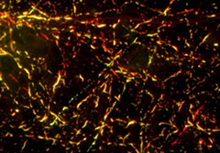Altered Protein Shapes May Explain Brain Diseases
Altered Protein Shapes May Explain Brain Diseases
Scientists may have uncovered a key mechanism involved in the brain degeneration seen in conditions such as Parkinson’s and Alzheimer’s disease.
Several neurological disorders are marked by proteins that aggregate, or accumulate in the brain. Normal proteins may become insoluble and clump together when they sporadically “misfold” and change shape. One protein, called tau, clumps into the twisted threads known as tangles that are a hallmark of Alzheimer’s disease. Alpha-synuclein clumps to form the Lewy bodies associated with Parkinson’s disease.

Accumulations of alpha-synuclein (red) and tau (green) in mouse brain cells treated with strain B. Overlap of the 2 proteins is shown in yellow. Courtesy of Dr. Virginia M.Y. Lee, University of Pennsylvania School of Medicine.
Different types of protein clumps often appear in the same patients. For example, more than half of Alzheimer’s disease patients also have Lewy bodies in their brains. The mechanism that underlies widespread protein misfolding isn’t well understood. One potential explanation is that the protein maintenance machinery has gone awry in diseased brains. Studies have also found that certain misfolded “seed” proteins can induce shape changes in other proteins they contact.
Alpha-synuclein and tau proteins can promote each other’s aggregation under certain conditions in the lab. Recently, a research team showed that synthetic alpha-synuclein fibrils can induce tau aggregation in non-neuronal cells. In their new study, the team—led by Drs. Jing L. Guo and Virginia M.Y. Lee from the University of Pennsylvania—explored these effects in neurons and in mice. Their work was funded in part by NIH’s National Institute of Neurological Disorders and Stroke (NINDS) and National Institute on Aging (NIA). The study appeared on July 3, 2013, in Cell.
The researchers tested different preparations of synthetic alpha-synuclein fibrils in cultured neurons. To their surprise, they discovered 2 strains of alpha-synuclein with distinct seeding activity. One, dubbed strain A, resulted in accumulation of alpha-synuclein alone. The other, strain B, caused accumulations of both alpha-synuclein and tau. A structural analysis revealed only subtle differences between the strains.
The researchers injected the synuclein strains into the brains of mice that were engineered to make large amounts of human tau. Mice that received injections of strain B showed earlier and greater accumulation of tau across more brain regions.
The researchers next examined the brains of 5 patients with Parkinson’s disease and dementia. Three also had a diagnosis of Alzheimer’s disease. The scientists found evidence that the 2 small subgroups harbored different structural forms of alpha-synuclein. This finding, while preliminary, supports the idea that different forms of alpha-synuclein may underlie different manifestations of disease.
“We are just starting to do work with human tissues,” Lee says. The team is now planning to look more closely at the brains of patients with different forms of Parkinson’s disease to see if there are differences in their alpha-synuclein.
“This study has important implications for Parkinson’s disease and other neurodegenerative disorders,” says NINDS Director Dr. Story Landis. “We know that among patients with Parkinson’s disease, there are variations in the way that the disorder affects the brains. This exciting new research provides a potential explanation for why those differences occur.”
###
* The above story is reprinted from materials provided by National Institutes of Health (NIH)
** The National Institutes of Health (NIH) , a part of the U.S. Department of Health and Human Services, is the nation’s medical research agency—making important discoveries that improve health and save lives. The National Institutes of Health is made up of 27 different components called Institutes and Centers. Each has its own specific research agenda. All but three of these components receive their funding directly from Congress, and administrate their own budgets.




















